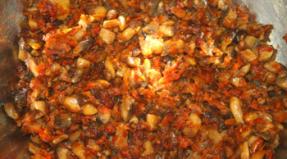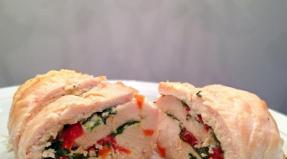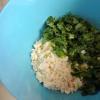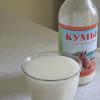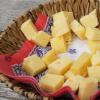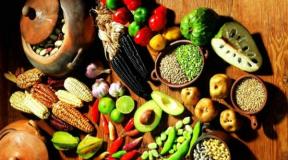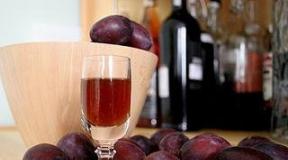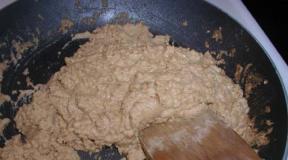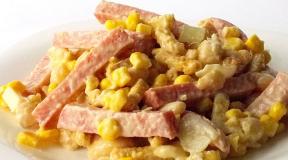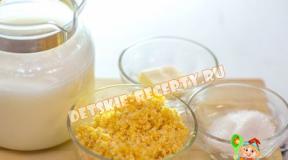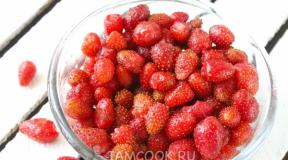Icing recipes for Easter cakes. Features and secrets of cooking
A lot of recipes have already been written. But in addition to white delicacy, colored glazing is also quite common. One that can be used not only for Easter bread, but also for all kinds of cakes, muffins and pastries on any other holidays and quite ordinary ones.
Just to please all sorts of goodies of their household.
Interestingly, the main ingredient of this sweet decoration can be not only proteins, gelatin and powdered sugar. Great taste and a beautiful smooth baking surface can be achieved with chocolate, egg yolks, lemon, starch and even cheese!
Don't believe! But in vain! Both the taste and color of such a product are quite saturated without any dyes and flavorings!
Somehow it is already customary that the glaze is prepared mainly on proteins. But quite an interesting and tasty option is obtained from the yolks.
And what is remarkable, if you cook it from store-bought eggs, then it turns out to be almost white. But if eggs from a domestic chicken with bright yellow yolks, then the coating will acquire a delicate, orange-lemon shade.

We will need:
- Chicken egg - 2 pcs.
- Sugar - ½ cup.
- Powdered sugar - ½ cup.
- Water - 2 tbsp. l.
Cooking:
1. First you need to get the eggs out of the refrigerator so that they get to room temperature. Then carefully separate the yolks from the whites using a special device, an egg separator. Or just carefully pour from shell to shell in the old "old-fashioned" way.

In order to get a great coating, it is best to use fresh eggs that are no more than a week old. Then it is much easier to separate the proteins from the yolks, and the necessary consistency of the finished sweetness is obtained much faster.
2. Pour sugar into the pan. Then add water there and mix well so that all the sugar becomes “wet”.
Put on a slow fire, and stirring constantly, achieve its complete dissolution and obtain a transparent homogeneous syrup. Turn off the heat immediately and allow a little time for the mixture to cool down.
It is important that during further manipulations during the preparation of the product, the yolks are not brewed in the syrup. While it's cooling, let's prepare the other ingredients.

3. To obtain a more delicate consistency of the finished mixture, powdered sugar must first be sifted through a strainer. This must be done in order to give her the opportunity to get enough air during this.

4. Combine the sifted powder with the yolks and beat the mixture well with a mixer. Beat until a beautiful, fluffy egg foam is formed. This should be done without delay, because the syrup will not wait, it also cools down quickly enough.

5. As soon as the sugar liquid has cooled to 40 degrees, we introduce the whipped yolk mixture into it in small parts. And stir quickly.
You can do this with a mixer. In this case, a beautiful and slightly viscous glaze is formed much faster.

6. Do not pull for a long time and wait for our coating to harden. It is best, as soon as it is cooked, immediately start decorating the finished baking.

Just do not forget that the muffin must already be cooled down, otherwise the smooth “cap” may slip off it.
Here is such an interesting recipe. I like him. And you try to cook on it. I think that he will not leave you indifferent.
Video on how to make gelatin icing that does not crumble or stick
I have already brought this recipe to your attention on this topic. But he is so good that you can not ignore him here.
And it should be noted that you can cook our decoration on it without eggs at all. You will probably be surprised and say that this is impossible. So it's possible, and how. For cooking, we will need gelatin.
In my opinion this recipe is amazing. And there are practically no worries with him. Everything is quick and easy, like twice two. This icing can be prepared for any other baking.
And since today we are more considering its preparation in color versions, then of course this yummy can be obtained in any color with the addition of additional natural ingredients.
Chocolate fudge made from powdered sugar and starch without eggs
A beautiful chocolate fondant can be quickly made from dark chocolate. But much more interesting, it turns out cooked using cocoa powder. In addition, it is also much more tender, even in color, even in taste.
In fact, the result of the recipe for making such a fudge resembles a hand-made chocolate paste.

We will need:
- Powdered sugar - 1 cup.
- Milk - 2 tbsp. l.
- Butter - 1 tbsp. l.
- Cocoa powder - 2 tsp
- Starch - 1 tsp
Cooking:
1. First you need to melt the butter. This can be done in several ways:
- just let it lie in an iron cup on the table at room temperature
- put in the microwave
- pour boiling water into a plate and put a cup of oil in it
In this case, it is not at all necessary to melt it to a liquid state. Just enough to make it very soft and pliable.
Let me remind you that it is better to have oil with a fat content of 82.5%.

2. Sift through a strainer into a cup with soft butter all loose ingredients: cocoa powder, powdered sugar and starch. And mix everything well until a homogeneous consistency.

3. Warm the milk just above room temperature (at least 30 degrees), and pour it into the buttery brown mixture in two passes. Being careful not to spill, mix until smooth.
Why exactly warm milk, and why should the butter be exactly warm?
And the answer is very simple. In order for the ingredients to be easily and simply combined, and for free-flowing components to not form lumps when mixed.

If you wish, then at this moment you can also add a spoonful of cognac, liqueur or condensed milk to give the fudge a little piquancy and amazing aroma.
4. Now the mixture needs to be simmered a little so that it thickens slightly, and begins to resemble liquid chocolate paste. But it shouldn't take more than 5 minutes.
You can also independently adjust the density during cooking: adding a little milk, you can get a slightly liquid mixture, but adding powder, on the contrary, will help to slightly thicken it.

If instead of cocoa powder, add 100 grams of melted bitter or white chocolate to this recipe, you will get an amazingly delicious chocolate-based fudge.
So experiment, and end up with a delicious product.
Butter White Chocolate Recipe
The preparation of coatings with chocolate is very popular not only for Easter cakes, but also for biscuit cakes, and even cakes of the "Bird's milk" type. You can, of course, use the previous recipe and the advice at the end of it, but this option is still different from the previous one.
The result of cooking gives a glossier and shiny glaze surface. And when you add food coloring to the recipe, you can get it in any desired color.

We will need:
- Powdered sugar - 1 cup.
- White chocolate - 100 gr.
- Butter - 1.5 tbsp. l.
- Water - 4 tbsp. l.
- Lemon juice - 1 tbsp. l.
Cooking:
1. Pour powdered sugar into a small saucepan, add water and lemon juice. Mix all the ingredients with a spoon, then put on a small fire. With constant stirring, boil the resulting sweet liquid by 1/4 of the volume (it should turn out ¾ of the syrup). Then cool a little.

1 st. l. lemon juice can be replaced with lemon water. To do this, it is enough to take citric acid in the amount of ¼ tsp. and mix it with one tablespoon of water.
2. At the same time, melt white chocolate with butter in a water bath. This can be done right away in one cup. After they are melted, we still need to gently mix them until a homogeneous consistency.

3. Allow the sugar syrup to cool slightly, then, with constant stirring, pour in the buttery chocolate mass in a thin stream. Beat it well with a whisk until you get a beautiful, delicate and slightly stretchy glaze.

4. So that it does not have time to harden and turn into a thick paste, it is immediately advisable to use a culinary spatula and apply it to the cooled pastries.

The sweet fudge-like mixture adheres well to the surface and is delicious. As I said above, if desired, it can be tinted with food coloring of any color.
The Perfect Starch-Based Egg-Free Recipe
Remember glazed gingerbread, like in childhood? They were insanely tasty and at the same time translucent tasty coating. We ate it first thing, just gnawing it.
It was a really perfect coating, which always lay evenly on the gingerbread, did not drain and never stick to hands after it hardened on baking.
Now it's time to remember this noteworthy recipe! And although eggs (in particular proteins) did not participate at all during the preparation, the fudge still turned out to be “glossy”. And she always looked quite original, even on Easter muffins, even on the same gingerbread, and even shortbread cakes.

We will need:
- Starch - 10 gr.
- Milk - 4 tsp
- Odorless sunflower oil - 1 tsp.
- Powdered sugar - 150 gr.
Cooking:
1. Sift the loose components (starch with powdered sugar) into a cup, and mix them well with each other with the usual stirring with a tablespoon or spatula. What will be more familiar and comfortable for you.

2. Pour in warm milk (you can just let it warm to room temperature, pulling it out of the refrigerator in advance) and mix thoroughly to get a uniform consistency.

3. Add sunflower oil and again mix all the ingredients well so that they do not delaminate, and a homogeneous plastic mixture is obtained.
You won't need to beat this for a long time. Just good mixing is enough to get a thick consistency that will drain slowly enough on a spoon.

4. After cooking, apply the icing evenly on the pastries, and leave it to “harden” for about 20-40 minutes. Then you can serve it to the table, or close Easter cakes to each other. They will no longer be afraid to stick to each other.
Bon Appetit!
The easiest lemon frosting recipe
Although the lemon coating usually turns out to be an opaque white color, it still looks like a slightly yellowish under the light angle. It also has a lemon scent. And his taste, though sweet, but still with a gentle sourness.
If you want to get a bright yellow color of such a glaze, then you can add a little yellow dye to the mixture, or orange juice.
There are quite a few different recipes for lemon sweetness, but my household loves it, cooked exactly according to the old recipe. Our family has been using it for many years.
It contains only two ingredients, but this does not prevent you from enjoying its taste and pleasing your eyes! And very often I glaze cupcakes, cookies and even sweet pies with her. I use it to give sweet pastries this unique sourness.

We will need:
- Lemon juice - 3 tbsp. l.
- Powdered sugar - 150 gr.
Cooking:
1. First you need to saturate the powder with oxygen and rid it of lumps by sifting through a strainer. This procedure is mandatory and should not be skipped.

The more magnificent the powder, the more airy and gentle the mixture is.
2. Pour lemon juice in small portions with constant stirring. You can do this with such “shuffling” or “rubbing” movements so that the juice penetrates well and evenly into the powdered sugar.
Just at this step, you can adjust the consistency: a little more juice - and the glaze is a little thinner, a little less - and it becomes a little thicker.

In this case, you should not use a mixer for mixing and whipping. Because of this, the powdered sugar can quickly crystallize and the coating will quickly crumble!
3. Beat the powder with lemon well until smooth. It is desirable to achieve a state where the mass will turn out to be slightly white and opaque, while a slight yellowish tint will be displayed.
You will also notice that the finished product becomes shiny almost immediately.

4. Dip the cooled pastries into the resulting mixture and let it dry a little.

If it turned out to be slightly watery, then you can get beautiful streaks on baking.
Delicate glaze of curd cheese and powdered sugar
Many people love curd cream in cakes and pastries. And you can make a magnificent tender glaze with curd cheese, which the sweet tooth will eat first. Moreover, if you put it on a still slightly warm Easter cake, then it will be slightly saturated with this cheese cream and become unusually tasty!

We will need:
- Curd cheese soft - 250g.
- Powdered sugar - 250 gr.
- Butter - 70 gr.
- Vanilla extract - 1 tsp
Cooking:
1. Beat warm butter well until creamy. It is better to do this with a mixer at low speed. In this state, the butter will be able to combine with the cheese more easily, since it will be almost the same consistency.

2. Put tender curd cheese into whipped butter. Philadelphia or its analogues are best suited. Turn on the mixer again and beat the cheese together with the butter so that they mix well with each other.

3. You can sift the powder on the cheese oily mixture, right on top, and again beat everything until smooth with a mixer at the lowest speed. The powder in this case will not scatter from the cup.
As soon as a beautiful shine and airy steady peaks appear, the glaze is completely ready.

4. It is advisable to immediately coat Easter bread with it and let it dry for half an hour.

Look what a beauty! Delicious, beyond words! Connoisseurs of cheese products will understand what is at stake.
Glaze like creamy caramel - very tasty
Do you like Milk Cow sweets? And my household members are happy to eat not only the sweets themselves, but also suck out the delicious liquid caramel filling with great pleasure.
Want to do something similar to taste in order to decorate the top of Easter cakes or any other sweet pies? Then I offer you a very tasty recipe for creamy caramel icing!

We will need:
- Powdered sugar - 180 gr.
- Brown sugar - 100 gr.
- Milk - 60 ml.
- Butter - 50 gr.
- Vanilla sugar - 8 gr.
Cooking:
1. Put the butter in a saucepan and let it melt a little over low heat.

2. Pour milk in a thin stream with constant stirring and mix it well with butter.

3. Pour brown sugar in small portions, and completely dissolve it. At the same time, make sure that the grains of sugar do not lie on the bottom and do not burn - otherwise the smell of burnt sugar may appear. The end result is a sweet syrup.

4. Stirring constantly, let the liquid boil and reduce it a little for two minutes. Then turn off the heat and put the saucepan on the hot stand on the table.

5. Divide the pre-sifted powder approximately in half. Pour one half first, while constantly stirring the mass. You can beat well with a mixer or a whisk, and then cool the resulting slightly thickened liquid to 40 degrees.

6. While stirring the cooled sugar-cream mixture, add the remaining half of the powder and vanilla sugar.
Beat with a mixer until a stable thick consistency appears. This will be the finished icing with a taste, as in those very delicious milk candies.

7. Using a culinary spatula, coat pastries or Easter cakes and let them stand for about 20-30 minutes so that the coating dries.

Looks delicious, doesn't it!
The photo shows what color can still be obtained to decorate the top of the products. This color can be achieved using natural or food coloring. You can tint the mixture with carrot or beet juice, spinach juice. We talked a lot about natural dyes!

How do you do it with food coloring?
Therefore, if you want to not only, but also decorate them in an original way, today's article can help you with this. Moreover, you can easily prepare such amazingly delicious types of glaze even for Easter, even for an ordinary pie or cake.
Bon appetit and a pleasant "gourmet" - the pleasure of unusual glaze!
Kulich is one of the main attributes of the festive Easter table, and every housewife puts her soul into baking and decorating it. Icing for Easter cakes plays its important role, pleasing to the eye and uplifting. Since ancient times, it has been believed that Easter cake is a symbol of good luck, health and fertility, and if it turned out to be magnificent and tall, then the coming year promises only happiness. Therefore, we treat baking incredibly reverently. With great responsibility and soul we approach the preparation of dough and decorations at home.
In vain do you think that the icing is just a white cap on the top of the cake. There are many types of Easter decorations. In addition, experienced housewives, in addition to the aesthetic appearance, make sure that the fudge sticks firmly to the cake and does not crumble.
How to make icing for cake
Cooks know 4 main types of homemade glaze: protein, chocolate, milk and sugar. But basic recipes can be improved by adding food colors and flavors.
- Protein glaze. The protein acts as a binder and at the same time a thickener, gives ductility and plasticity. After drying, it gives a hard surface, does not flow down and crumbles a little.
- Icing. Without eggs, based on water with sugar and lemon.
- Dairy. It is brewed from milk, powder and butter. When solidified, it remains soft and slightly moist, which many people like.
- Chocolate. You can cook according to any recipe using chocolate pieces or cocoa powder as a filler.
Attention! Replace granulated sugar with powdered sugar. Then grains will not be felt in homemade fudge.

Protein glaze - a classic recipe
This icing is called royal icing. Check out the basic recipe for egg white Easter icing for Easter cake. It turns out a snow-white dense fudge, which is applied to a cooled cake.
You will need:
- Egg white - 2 pcs.
- Sugar, small - a glass.
- Lemon juice - 3-4 tablespoons (I suggest orange as an alternative).
How to make egg white frosting:
- Cool the whites a little and beat. Work at medium speed. Start adding sugar in batches and gradually increase the speed of the mixer to maximum.
- The result should be a thick foam with stable peaks. The consistency is viscous and thick. Do not spare time for whipping, then the cap will come out white and fluffy.
- The glaze dries for a long time, but to speed up the process, you can put the cakes in the oven for 15-20 minutes. Make the temperature no higher than 160 o C.

Icing sugar for Easter cake
It will take less time to whip if you take powdered sugar instead of grains of sugar. Do not expect quick drying, as the mass is quite liquid. If you want to get a thicker cap, apply a layer of glaze, wait until it dries completely and re-layer. Make the number of layers as you wish.
Take:
- Powder - 100 gr.
- Lemon juice - 3-4 tablespoons.
How to make icing for cake:
- Mix powder with juice and stir well. The mass should drain slowly from the spoon. In too liquid, add a little more sweet ingredient.
Glaze with gelatin that does not crumble
Many housewives face this trouble - the icing crumbles and crumbles before Easter. In addition, it sticks unpleasantly. The problem is solved by gelatin, endowed with the ability to hold the mass together. Here is a simple recipe for making quick-drying Easter icing. Note that we will make the icing without eggs. If you want to diversify the recipe, add a couple of tablespoons of cocoa powder or a few drops of lemon juice at the whipping stage.
Advice! Do not use last year's gelatin. Take a new one, then it will behave correctly.
You will need:
- Gelatin - ½ teaspoon.
- Sugar - 100 gr.
- Water - 3 large spoons.
How to make gelatin frosting:
- Dissolve the gelatin crumbs in a spoonful of hot water, stir.
- In a separate saucepan, combine sugar with 2 tablespoons of water. Bring to a boil, stirring the syrup continuously.
- Immediately pour in the gelatin, stir and remove from heat. Continue stirring for another minute.
- Let the fudge cool for a day and beat with a mixer into a strong foam. Don't let it cool too much or the icing will caramelize and you won't have time to spread the cake.
- Whipped fondant can be spread on a cold or hot cake - it will seize almost instantly. A thin layer will need 7-10 minutes to completely solidify. I do not advise making a thick layer, it will drain.
- Sprinkle for decoration also do immediately.

Soft Milk Glaze Recipe
With a delicate almond flavor and vanilla aroma, milky glaze is perfect for decorating Easter calls.
You will need:
- Milk - 200 ml.
- Vanillin - 2 teaspoons.
- Butter - 100 gr.
- Almond extract - a small spoon.
- Powdered sugar - 400 gr.
How to cook fondant for Easter cakes:
- Pour milk into a saucepan, add butter.
- Put on the stove and bring to a boil.
- Remove from heat, add extract and vanilla. Pour in the powder and stir.
- Beat with a mixer until thick and apply to the cooled cakes.
How to make chocolate icing for cookies
For those who cannot live without chocolate, this glaze recipe is suitable. If desired, orange liqueur or vanillin is added to the mass.
Take:
- Sugar - 100 gr.
- Water - 60 ml.
- Cocoa powder - 2 large spoons.
- Butter - 50 gr.
How to make frosting:
- Dissolve the powder in water, stir to break up lumps.
- Add sugar, stir.
- Put on gas, add oil (for speed, cut it into pieces).
- Wait until it boils and cook, stirring constantly. Once the frosting has thickened to almost the right consistency, remove the saucepan. Keep in mind that as it cools, the mass will become somewhat thicker.
Recipe for chocolate icing so that it does not crumble
The second option for preparing decorations is made from natural chocolate. But there is one secret here: so that the icing does not crumble, you need to add one ingredient.
- Take: a bar of chocolate weighing 100 grams. and 30 ml. fat cream. Chocolate is suitable for any - bitter and milk. Love white icing - take the appropriate variety.
- Warm the cream in a ladle, throw in the broken chocolate on the bars and, stirring, wait until it melts. Apply to a cold cake.

Powdered sugar frosting
I know that many people are afraid to put raw eggs in fudge because of the danger of catching something bad. In this case, I have a recipe for custard glaze.
- Protein - 2 pcs.
- Powdered sugar - 100 gr.
Cooking glaze:
- Combine the powder with protein and put to boil in a water bath. Cooking time with constant stirring 3-5 minutes after boiling.
- Remove from the burner and continue stirring for an additional 5-10 minutes.
Secrets of the perfect icing for Easter cake
In order not to spoil the holiday, get acquainted with some of the nuances of cooking Easter icing on Easter cakes.
- Apply icing to a cold cake, unless otherwise specified in the recipe.
- First bake the Easter cakes, and then cook the glaze, as it dries quickly.
- I recommend sifting powdered sugar, removing grains, they look messy in the finished fudge and spoil the festive mood.
- Take the time to knead and whip the mass - the surface of the cake should be perfectly smooth.
- Decorate pastries not only on top - apply patterns on the sides, the cake will look charming and original. To do this, lay it on its side, draw a pattern and let it dry. Then flip over to the other side.
How to decorate Easter cakes:
Ready-made topping is too boring. Decorate Easter cakes with candied fruits, coconut shavings, chocolate pieces or grains, chopped nuts, marmalade pieces, dried fruits.
Paint white frosting
Easter is a bright and joyful holiday. I propose to color the traditional white icing at home, making Easter cakes bright and elegant. Food coloring of different colors will help here. Do not want to use synthetic dyes - use natural juices.
You can make fudge according to the number of all Easter cakes, and then divide it into bowls and add a certain dye to each.
I advise you to start with a small amount, filling up first on the tip of a spoon. After stirring, the color can be made more saturated by adding a little more. From myself I recommend not to overdo it with paint. I know from experience that Easter cakes of a delicate color look the most advantageous.
Video recipe with icing sugar recipes for Easter cakes. Have a nice and unforgettable holiday!
Easter cake icing is the main decoration of Easter. And since the preparations for the Easter holiday are in full swing, the housewives have probably already managed to think about how to decorate pastries at home.
There are many ways to make icing for Easter cake: this is lemon, and protein fudge, and even chocolate. We offer several recipes, and it’s up to you to decide whether you cook something specific, or use several options at once.

The classic version of the icing recipe for Easter cake includes the following ingredients:
- eggs, preferably chicken - 2 pcs.;
- sugar, can be ordinary, or cane - 1 tbsp.;
- salt - a pinch is enough.
We take chilled eggs and separate the whites from the yolks. We do this as carefully as possible - so that not a single drop of the yolk gets into the bowl with the proteins. Next, to prepare the sugar icing for the Easter cake, we begin to beat the eggs with a mixer with the addition of salt so that the foam is thicker and more fluffy.
When the foam in the sugar fudge for Easter cake has become as lush as possible, we begin to add sugar in small portions. Continue whisking until all the sugar has gone into the icing and has dissolved.
We spread the mass on Easter cake (necessarily cooled down) and sprinkle confectionery decorations on top until it has cooled down. If necessary, the icing applied to pastries can be dried.
Protein fudge

Another option for fondant with eggs is white icing for Easter cake. This recipe calls for powdered sugar. So, you will need:
- icing sugar (you can grind regular granulated sugar) - 1 tbsp.;
- egg white - 1 pc.;
- fresh lemon juice - 1 tsp;
- table salt - a pinch will be enough.
For the preparation of protein glaze, you will not need the whole egg, namely the egg whites. Therefore, first carefully separate the whites from the yolks, as in the previous recipe. Whisk the protein thus obtained for protein glaze for Easter cake for several minutes with a pinch of salt until a thick foam is obtained. It is important that the protein is chilled.
When the foam becomes thick and starts to hold its shape, you can add powdered sugar. It is necessary to use powdered sugar, as it dissolves without lumps. Of course, regular sugar can also be used, but then you need to make sure that it dissolves completely and does not settle to the bottom, since sugar is heavier.
Lastly, we introduce lemon juice into the protein glaze for Easter cake in parts. At the same time, you need to continue to beat the fondant for the Easter cake with a mixer until it turns out to be homogeneous in consistency. As a result, lemon juice will make the icing for Easter cake itself dense, and thanks to citrus, pastries will acquire a pleasant taste.
By the way, not many people know that other juice can be used in the same way for Easter cake fudge - for example, pomegranate, pineapple, orange or even cherry. Depending on what taste you want to end up with. In addition, this lemon icing for Easter cake will help make the sweet taste less cloying.
Based on lemon juice

Delicious icing for Easter cake is obtained on the basis of lemon. To make it, you need a minimum amount of ingredients. The result is a white icing for Easter cake - moderately sour, but very fragrant. And the method of preparing it is very simple and does not take much time.
To make lemon curd frosting you will need:
- lemon or other citrus juice - 2 tbsp. l.;
- sugar, but ideally powdered sugar - 100 g.
The preparation of delicious glaze without eggs is as follows:
- We take powdered sugar and sift it so that there are no lumps in it.
- Gradually add lemon juice to powdered sugar. After each addition of juice, grind it with powder. When homemade icing for Easter cakes becomes opaque and glossy, it is ready.
If, as a result of cooking, the icing for the Easter cake has become too thick, it can be diluted with a little water or the same lemon juice. The mass is applied to hot cakes.
Sugar icing without eggs

A feature of the fudge recipe is the fact that it is applied to a cold cake. But there is another advantage as well. Homemade icing for Easter cakes without eggs is completely safe, since you do not need to beat raw eggs.
For cooking you will need:
- powdered sugar or sand - 200 g;
- milk, which can be replaced with cream - 40 ml.
Boil milk. Pour the milk that has not yet cooled down into the powder and mix it until a thick mass. Moreover, the more powder you take, the more glaze you will end up with. And the milk must be poured in gradually so as not to pour too much and so that the icing for the Easter cake from powdered sugar does not turn out to be too liquid.
chocolate fondant

An ideal option for decorating Easter is chocolate soft icing for Easter cake. You can cook it without eggs, which is an additional plus. For the frosting recipe you will need:
- any chocolate bar, dark can be - 90 g;
- orange juice, which can be replaced with lemon, pineapple or any other - 3 tbsp. l.;
- coconut oil or butter - 3 tbsp. l.;
- granulated sugar or powdered sugar - 3 tbsp. l.
To prepare chocolate sugar fudge for Easter cake, you need to put all the ingredients in one bowl, put it in a water bath and wait until the whole mass turns into a homogeneous one. Apply frosting to cold cake.
Toffee in milk

Very tasty and tender is the icing for hot Easter cakes from toffee and milk. To prepare it, we need:
- candy Russian "Iriski" (preferably harder) - 200 g;
- coconut oil - 40 g;
- milk, easily replaced by cream - ¼ tbsp. l.;
- regular sugar or powdered sugar - 2 tbsp. l.
In a saucepan over low heat, melt milk with butter, bring to a boil and reduce. Slowly introduce powder here and add toffee. Cook all the ingredients until the mass becomes homogeneous. Put on cake. This preparation of fondant will take a little longer, but this is an icing for an Easter cake that does not crumble.
with gelatin

There is a delicious icing option for Easter cakes with gelatin without eggs. Its additional advantage is that it does not crumble.
To make this unique fudge you will need:
- powdered sugar or sand - 1 tbsp.;
- instant gelatin - 1 tsp;
- lemon or orange juice - a few drops;
- boiled water - 2 tbsp. l. for gelatin and 4 tbsp. l.
To prepare the glaze for Easter cakes on gelatin, you need to pour a bag of gelatin with water in an amount of 2 tbsp. l. And leave it to swell for 5-10 minutes.
While the gelatin swells, pour sugar into the pan, 4 tbsp. l. water and simmer until all ingredients are dissolved. Next, bring to a boil.
Cool the sugar mass to 60 degrees. Add gelatin to it and beat thoroughly with a mixer until the icing for Easter cakes on gelatin becomes lush and white.
It is necessary to apply such icing for Easter cakes that does not crumble as quickly as possible, as it quickly hardens.
Fruit and berry options

In order to prepare such icing for Easter, take:
- chicken egg - 1 pc.;
- powdered sugar (if it is not, then you can replace it with sand) - 3/4 tbsp.;
- juice from berries or concentrated fruit compote - ¼ tbsp.
To prepare, you need to beat the protein for several minutes, introducing the powder in parts. Then, little by little, introduce fruit juice for color and taste, without turning off the mixer. Put the finished mass on the cake.
lemon glaze

To prepare this recipe, take:
- regular sugar - 2/3 tbsp.;
- lemon juice - a couple of tbsp. l.;
- butter - a couple of tbsp. l.
First you need to put the butter in a saucepan, melt it over low heat, and then gradually add sugar and lemon juice. Grind all the ingredients in such a way that a homogeneous mass is obtained. The result will delight you with the fact that the mass does not stick at all.
As you can see, there are many frosting recipes. When choosing, everything will depend on your desires and preferences, as well as the products available in the refrigerator.
Useful video on how to make icing for marshmallow cake
Answer
When Easter cakes are ready, think about decoration options, so that pastries will not only be tasty, but also beautiful. One of the most popular types of decoration is cake icing, which is made from proteins and sugar. But if you diversify the ingredients, you can make icing for Easter cake with chocolate, gelatin and lemon juice.
Chocolate glaze with cream
The icing for Easter cake prepared according to this recipe is glossy after hardening and is prepared without an egg. Chocolate is better to take with 70% cocoa.
Glaze is ready for 30 minutes. Only 800 kcal.
Ingredients:
- two l.h. powdered sugar;
- 120 g of chocolate;
- 50 ml. cream;
- 30 gr. drain. oils;
- 50 ml. water.
Cooking:
- Break the chocolate into cubes, put in a bowl and melt in a steam bath.
- When the chocolate starts to melt, add a little water and stir.
- Pour in the powder and continue to hold the bowl over the steam.
- Pour in the cream and stir.
- Place butter in bowl with chocolate. When it melts, the glaze is ready.
Before decorating the cake, the icing for the Easter cake should cool slightly. The first layer of glaze should be thin.
Icing sugar with gelatin
The sugar icing for Easter cake does not crumble when cutting pastries, because it is prepared with gelatin and turns out to be viscous and homogeneous. You can add dyes to it.
Calorie content - 700 kcal. It will take an hour to prepare the glaze.
Ingredients:
- one tsp gelatin;
- half stack. water + 2 tsp;
- stack Sahara.
Cooking:
- Pour gelatin in a bowl with two tablespoons of water, leave to swell for 30 minutes.
- Pour sugar with water and put on a small fire, stirring until dissolved.
- When the syrup becomes transparent and resembles liquid honey in consistency, add gelatin and beat with a mixer until white.
- Decorate Easter cakes with finished and slightly cooled icing and put them in the oven for 5 minutes at 180 degrees so that the icing becomes elastic. It is important to pull out the Easter cakes exactly after 5 minutes, so that the icing does not darken and crumble.
Ingredients:
- a pinch of salt;
- two proteins;
- stack Sahara.
Cooking:
- Put the whites in the refrigerator for a while: they must be chilled before whipping.
- Add salt to the chilled proteins and beat with a mixer, increasing the speed to get a thick foam.
- Continue beating and gradually add the sugar to dissolve.
- When finished, cover the cooled cakes in two layers with icing.
The icing of Easter cakes must be left to harden at room temperature.
White chocolate icing
White icing from Easter cake can be made from white chocolate, which will look festive.
Ingredients:
- chocolate bar;
- two tbsp. milk;
- 175 g of powdered sugar.
Cooking:
- Break the chocolate into small pieces and melt in a water bath.
- Mix a spoonful of milk with powder and pour into chocolate.
- Stir the icing until you get a homogeneous thick mass.
- Pour in the rest of the milk and beat the glaze with a mixer.
Decorate the cake with icing while it is warm. You can also sprinkle powder and decorations, coconut or nuts on it. Calorie glaze approximately 1080 kcal. Glaze is ready for 30 minutes.
Chocolate glaze with starch
Chocolate icing for Easter cake with the addition of starch does not thicken quickly and can be applied to cooled and hot pastries.
Ingredients:
- spoon st. starch;
- three st. l. cocoa;
- three tbsp. potato starch;
- three tbsp. water.
Cooking steps:
- Sift the powder and mix with starch and cocoa.
- Pour in cold water and stir the mixture thoroughly.
- Cover the cakes with the finished icing.
It will take quite a bit of time to prepare the glaze - about 15-20 minutes. Calorie content - 1000 kcal.
Good afternoon. If you are a frequent visitor to my blog, then you have probably already seen the recipes of the most, and most likely have already decided how you will make the dough for such Easter baking. And rightly so, because your mood and your holiday table will depend on what kind of pastries you get.
But learning how to cook one dough is not the whole task, because it is also important to be able to beautifully and correctly prepare icing for Easter cakes. Therefore, today we will talk about it.
It is not enough to prepare a seemingly tempting texture, it is important that it is also tasty, and most importantly, it does not sprinkle when cutting the cake itself. How to prepare such a sweet? You ask. Yes, easy and simple! Read the recipes below and choose to your taste, and I am responsible for the quality.
Secrets of making glaze for Easter cakes:
- The icing should not be too thick and not too liquid, reminiscent of thick sour cream.
- If you get a liquid consistency, then add a teaspoon of powdered sugar, if on the contrary, thick - a teaspoon of hot water.
- Cook sugar syrup over low heat, stirring constantly.
- Add lemon juice, it adds flavor and smell. You can also replace it with citric acid.
- Always start whipping at low speed and gradually increase to maximum.
- To add color, add food coloring, cocoa or chocolate.
- Remove all crumbs, if any, from baking immediately before application.

In fact, my favorite baking coating is protein-sugar, which I described in detail.
Therefore, I decided not to repeat myself and not dwell on that recipe, but prepared new and interesting options for you. And the first type is milk fudge, because it is very easy to prepare and does not cause any difficulties. And it does not settle, unlike a protein cream.
Ingredients:
- Milk - 50 ml;
- Powdered sugar - 2.5 tbsp.;
- Lemon juice - 1 tbsp. a spoon.
Cooking method:
1. In a deep bowl, mix powdered sugar and milk, add lemon juice and beat the mixture until thick.

2. Wait until your cakes are completely cool and apply fondant on them.

Important! It is impossible to apply such icing on hot pastries, otherwise it will all be absorbed inside and will not remain on the surface.
3. Moreover, it is better to pour the mixture evenly from above, and do not smear it with a spatula.

4. Then decorate the cakes with sprinkles and leave them until the milk cream has completely solidified.

If you want to get a color version, then just add a drop of food coloring. You can also use cocoa and chocolate. Such an addition is possible in all the recipes described in this post.

Icing for Easter cakes with gelatin
The next type is popular among culinary specialists and is characterized by fairly good solidification, plus it does not crumble when cut, and another positive quality is that such decoration can be applied to still warm products.

Ingredients:
- Sugar - 1 tbsp.;
- Water - 6 tablespoons;
- Gelatin - 1 tsp;
- Lemon juice - 1/2 tsp;
- Vanillin - to taste.
Cooking method:
1. Take instant gelatin and add 2 tbsp to it. cold water, stir. Leave for 5-7 minutes to swell.

2. At this time, pour sugar into an aluminum bowl or saucepan, pour in the remaining water (4 tablespoons) and add vanilla.

3. Put everything on a small fire and bring to a boil, but do not boil, but stir continuously so that the sugar is completely dissolved. At the end, add lemon juice and mix everything.

4. Add the prepared gelatin to the hot syrup and mix well. In this case, the gelatin should completely dissolve.

5. Then our mixture must be beaten for 3-5 minutes with a mixer until a snow-white consistency.

6. Everything is ready. Immediately apply our mass to pastries, as it quickly and well hardens.

If you have left the prepared glaze and frozen, then you can always melt it in a water bath and grease the Easter cakes again.
How to make icing without eggs so that it does not crumble
Well, now I suggest you make a classic sugar fudge. I think you know this option, but it also has pitfalls. Therefore, maintain the ratio of water and sugar correctly, and do not overexpose the sugar syrup on the stove, otherwise you can spoil the entire icing.
Ingredients:
- Sugar - 250 gr.;
- Water - 75 ml;
- Lemon juice - 1 teaspoon.

Cooking method:
1. Take a saucepan and pour cold water into it. Pour in sugar and stir.

2. Put our workpiece on medium heat and start stirring the mixture continuously until boiling so that the syrup does not burn and has a caramel hue.

3. After the sugar is completely dissolved and the water boils, add lemon juice.


In order to check the readiness of the syrup, you need a drop of this syrup, which must be cooled in cold water. If it is plastic and a ball easily rolls out of it, then the syrup is ready.

5. Pour the finished hot syrup into a clean bowl and place in a bowl of cold water. It is necessary that the syrup cools down to 35-40 degrees.

6. When the syrup has cooled, beat it at medium speed with a mixer. If you did everything right, then your fudge will thicken and turn white.

Cooking in a blender with egg and sugar
Here is another very simple icing sugar recipe, but with protein. It is prepared simply, the taste and color is perfect, try it, you will not regret it.
Ingredients:
- Eggs - 2 pcs.;
- Sugar - 5 tablespoons;
- Lemon juice - 1 teaspoon.
Cooking method:
1. Separate the whites from the yolks. Place egg whites in a clean bowl.

It is necessary to separate the proteins very carefully so that even a drop of the yolk does not accidentally fall.
2. Add lemon juice and 1 tbsp. Sahara. Beat the mixture with a whisk for half a minute. Put all the remaining sugar and already start whipping with a blender (you can also use a mixer) at medium speed.

3. Beat for 3-4 minutes, until hard peaks appear.

4. Everything is ready. All you have to do is spread cream on your pastries and decorate with sprinkles on top.

Fondant for Easter cakes, which is not sticky and hardens well
Another option on gelatin and without eggs. This time I suggest you watch an excellent video story, everything is told in detail in it, and even shown.
Icing for Easter cakes from powdered sugar and protein
Many people prefer to make our cream without sugar and replace it with powdered sugar, and they do it right. I also like this option. Since the consistency of the fondant is very delicate and airy.
Ingredients:
- Egg white - 2 pcs.;
- Powdered sugar - 250 gr.;
- Lemon juice - 1 tbsp. a spoon.
Cooking method:
1. Beat the whites with a whisk by hand.

2. Gradually pour in the powdered sugar, but do not beat, but mix well.

3. Add lemon juice and beat our icing at the lowest speed of the mixer.

Such a mass can be stored in the refrigerator for up to 7 days, the main thing is to pack it tightly in a container or cover with a film so that it does not dry out.
white chocolate recipe
Well, this is for lovers of something new and crazy delicious. It turns out a real cream that can be used not only for Easter cakes, but also for cakes.
Ingredients:
- White chocolate - 100 gr.;
- Powdered sugar - 100 gr.;
- Sour cream - 0.5 tbsp.;
- Butter - 100 grams.
Cooking method:
1. Break a bar of chocolate and place it in a bowl over a steam bath.

2. As soon as the chocolate starts to melt, add the butter. Start constantly stirring the mass until the chocolate and butter are completely dissolved.

You need to melt chocolate in a steam bath along with sugar and butter, constantly stirring the mass.
4. After the mixture has become homogeneous, remove it from the steam bath and cool slightly. Add sour cream and beat thoroughly with a whisk. Your white frosting is ready.

How to make icing for Easter cake at home?
If you are afraid that you still may not get the icing according to the recipes described above, then do not worry, the next option is for you, it always turns out 100%.
You need to buy meringue powder and luck is in your pocket. And most importantly, such a fudge will not crumble, so do it to your health and the envy of everyone.
Ingredients:
- Powdered sugar - 500 gr.;
- Warm water - 370 ml;
- Meringue powder (meringue) -1 tbsp;
- Vanilla liquid flavor - to taste.
Cooking method:
1. First, mix the powdered sugar and meringue powder together.

2. Then heat the boiled water to 35 degrees.

3. Add a few drops of vanilla flavor to the dry mixture, mix.

4. Pour in water and start mixing the components with a mixer, starting at low speed.

5. Continue to beat the consistency, gradually increasing the speed.

6. It is necessary to beat the cream until a dense mass is obtained.

7. The end of whipping will indicate that the icing will hold well on the whisk.


9. And after 5 minutes, decorate the pastries as desired.

As you can see, all the recipes are not complicated and everyone can learn how to make icing. The main thing is to choose what you like and cook with love. And then your Easter cakes will delight you and your loved ones both externally and internally. Well, that's all I have for today. See you! I look forward to your comments.
